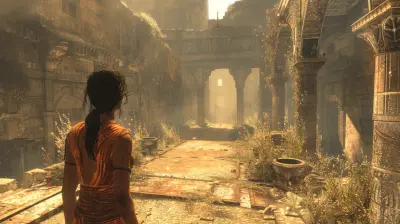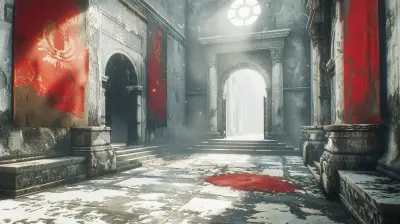From Pixels to Plotlines: How Video Games Became Great Storytellers
20 September 2025
Once upon a time, video games were just about jumping over barrels, shooting aliens, or collecting coins. The goal was simple: beat the high score or survive the level. Fast forward to today, and we're neck-deep in emotionally charged narratives, character arcs that rival TV dramas, and plot twists that can leave you speechless. So, how did we get here? How did video games go from pixelated playgrounds to becoming one of the most powerful storytelling mediums in modern entertainment?
Let’s hit pause on gameplay for a moment and explore how video games grew up to tell stories that stay with us long after we’ve put down the controller.![]()
The Humble Beginnings: Gameplay Over Story
Back in the '80s and early '90s, video games were all about gameplay mechanics. Think Pac-Man, Tetris, and Donkey Kong. These were fun and addictive, but let’s face it—they weren't exactly rich in narrative.The tech just wasn't there yet. Limited hardware meant developers had to focus on raw gameplay. You couldn't exactly cram an Oscar-worthy story into a few kilobytes of memory. So, most games offered a simple premise: rescue the princess, save the world, or chase a high score.
But even in these early days, seeds of storytelling were quietly being planted.![]()
The Shift Begins: 16-Bit Era and Narrative Hints
As the 16-bit era rolled in with consoles like the Super Nintendo and Sega Genesis, things began to change. Developers had more room to work with—literally. More cartridge space meant more dialogue, more cutscenes, and more room for richer narratives.Games like Final Fantasy VI and The Legend of Zelda: A Link to the Past started weaving deeper tales. Suddenly, players weren’t just hacking away at enemies—they were moving through worlds with emotional depth, facing moral dilemmas, and forging bonds with characters.
The bar was slowly being raised.![]()
Cinematic Influence: When Games Started Feeling Like Movies
The late '90s and early 2000s? That was a golden age. New consoles like the PlayStation and later the PlayStation 2 ushered in a new era of cinematic ambition.Enter Metal Gear Solid, Silent Hill 2, and Final Fantasy VII. These weren’t just games; they were experiences. Cutscenes felt like mini-movies. Voice acting started becoming a thing. Emotional plotlines pulled players into the lives of the characters.
Here’s the wild thing—people started crying over games. That scene in Final Fantasy VII (you know the one)? Absolute heartbreak. Players were fully invested, and games were now writing stories worth telling.![]()
Interactivity: The Secret Sauce of Game Narratives
Now, here’s what really sets video games apart from books or movies: interactivity. You don’t watch the story—you become part of it.Games like The Walking Dead series by Telltale introduced a new kind of storytelling. It wasn't just about watching events unfold; your choices shaped the story. Characters lived or died based on what you did. You felt the weight of your decisions, and the story became personal.
That emotional connection? It’s hard to replicate anywhere else. You’re not just rooting for the hero—you are the hero.
Open Worlds, Open Stories
As hardware became more powerful, developers began crafting vast, open worlds filled with lore and narrative depth. Think The Elder Scrolls V: Skyrim, The Witcher 3: Wild Hunt, and Red Dead Redemption 2.These games blurred the lines between main quests, side quests, and simple exploration. Every NPC had a backstory. Every abandoned shack might hide a diary filled with heartbreak. The world itself told a story.
In these worlds, players weren’t just following a plot—they were carving out their own legends.
Indie Games: Storytelling Without Boundaries
And then came the indie revolution.Without the pressure of million-dollar budgets or corporate publishers, indie developers had the freedom to take risks. The result? Some of the most emotionally resonant stories in gaming.
Titles like Journey, Celeste, Firewatch, and Undertale proved that you don’t need hyper-real graphics or blockbuster budgets to tell a compelling story. These games hit you right in the feels, often using minimalist design and subtle narrative techniques.
They reminded us that sometimes, less is more—and that great storytelling is about connection, not complexity.
Voice Acting, Motion Capture, and Realism
Picture this: you're playing The Last of Us, and Joel just broke down sobbing. You feel every ounce of his grief. How? Because AAA studios are now investing heavily in motion capture, professional voice actors, and film-quality production.Gaming narratives aren’t just written well—they're acted well.
Naughty Dog, Rockstar Games, Santa Monica Studio—they've all pushed the boundaries of storytelling by making characters feel real. Their body language, voices, and expressions all contribute to storytelling.
It’s not just writing anymore. It’s performance art.
Story First, Genre Later
Once upon a time, the story had to fit the genre. A shooter was about blowing stuff up. A platformer was about jumping around. But today? Genres are just tools to tell a bigger story.Look at BioShock. It’s a first-person shooter, sure, but it also critiques philosophy and dives deep into dystopian storytelling. Or Hades, a roguelike action game that uses its repetitive structure as a narrative device to explore Greek mythology.
Games have started asking bigger questions. Who am I in this world? What do my choices say about me? What happens after I die—again, and again?
The lines are getting beautifully blurry.
Emotional Investment and Character Development
Let’s talk about something important: emotional investment.You don’t just play as Geralt or Ellie or Arthur Morgan. You become them. You see the world through their eyes, make choices they would—or wouldn’t—make, and grow with them.
This is no small feat. Character development in games has gotten so strong that you genuinely miss these people when the story ends. Some games even give you post-game blues—you know, that hollow pit of “What now?” after the credits roll.
It’s like finishing a really good book, but deeper, because you lived it.
Storytelling Through Environment
Here’s a cool thing games do—something movies and books just can’t.They tell stories through the world itself.
Games like Dark Souls or Hollow Knight don’t spoon-feed you information. You uncover the lore through item descriptions, cryptic dialogues, and environmental clues. That abandoned castle? It’s not just level design—it’s history. It means something.
This kind of storytelling rewards curiosity. It invites players to dig deeper, to piece things together like detectives. And that, honestly, feels super satisfying.
Social and Cultural Commentary
More and more, video games are tackling big themes. Mental health. Identity. War. Loss. Redemption.Games like Hellblade: Senua’s Sacrifice give you a glimpse into the world of someone struggling with psychosis. Papers, Please forces you to make soul-crushing choices as an immigration officer in a dystopian regime. These aren’t light stories—they’re meaningful.
Video games have become a mirror, reflecting society and asking tough questions. And because players are active participants, the impact is even greater.
So, Are Games the Best Storytelling Medium?
That’s the million-dollar question. Books give you imagination. Movies give you visuals and sound. TV shows give you time to get attached.But games? Games give you control.
You're not just along for the ride—you’re at the wheel. That agency creates a bond with the story that’s hard to match. When you make a choice, see the consequences, and feel the emotions—they’re yours. Not the character’s. Yours.
And that’s what makes video games such powerful storytellers.
The Future of Game Narratives
Looking ahead, things only seem to be getting better. With AI-driven dialogue, procedurally generated story arcs, and increasingly immersive VR experiences, the boundaries of storytelling keep expanding.Imagine a game that writes its plot based on your emotions, voice input, or facial expressions. It sounds wild now, but it’s probably just around the corner.
One thing’s clear—video games aren’t just games anymore. They’re stories waiting to be lived.
Final Thoughts
From the modest 8-bit beginnings to today’s epic sagas, video games have transformed into one of the most emotionally engaging and creatively diverse storytelling mediums out there.We’ve gone from pixels to plotlines, and honestly? There's no going back.
So next time someone says, “It’s just a game,” smile and hand them a controller. The story’s just getting started.
all images in this post were generated using AI tools
Category:
Game StorylinesAuthor:

Tayla Warner
Discussion
rate this article
1 comments
Lydia Howard
Pixels may have started as mere dots, but now they weave epic tales! If you're still dismissing video games as mindless fun, maybe it's time to trade in your dusty novels for a controller. Welcome to the future of storytelling – where every choice matters and every plot twist slays!
September 21, 2025 at 4:28 PM

Tayla Warner
Absolutely! Video games have transformed storytelling, inviting players to experience narratives in an interactive and impactful way. It’s a thrilling evolution!


